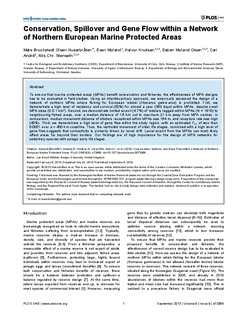Conservation, spillover and gene flow within a network of northern European marine protected areas
Huserbråten, Mats Brockstedt Olsen; Moland, Even; Knutsen, Halvor; Olsen, Esben Moland; André, Carl; Stenseth, Nils Chr.
Journal article, Peer reviewed
Permanent lenke
http://hdl.handle.net/11250/138275Utgivelsesdato
2013Metadata
Vis full innførselSamlinger
Originalversjon
Huserbråten, M. B. O., Moland, E., Knutsen, H., Olsen, E. M., André, C., & Stenseth, N. C. (2013). Conservation, spillover and gene flow within a network of northern European marine protected areas. PLoS ONE, 8(9), 1-10. doi: 10.1371/journal.pone.0073388 10.1371/journal.pone.0073388Sammendrag
To ensure that marine protected areas (MPAs) benefit conservation and fisheries, the effectiveness of MPA designs has to be evaluated in field studies. Using an interdisciplinary approach, we empirically assessed the design of a network of northern MPAs where fishing for European lobster (Homarus gammarus) is prohibited. First, we demonstrate a high level of residency and survival (50%) for almost a year (363 days) within MPAs, despite small MPA sizes (0.5-1 km2). Second, we demonstrate limited export (4.7%) of lobsters tagged within MPAs (N = 1810) to neighbouring fished areas, over a median distance of 1.6 km out to maximum 21 km away from MPA centres. In comparison, median movement distance of lobsters recaptured within MPAs was 164 m, and recapture rate was high (40%). Third, we demonstrate a high level of gene flow within the study region, with an estimated FST of less than 0.0001 over a ≈ 400 km coastline. Thus, the restricted movement of older life stages, combined with a high level of gene flow suggests that connectivity is primarily driven by larval drift. Larval export from the MPAs can most likely affect areas far beyond their borders. Our findings are of high importance for the design of MPA networks for sedentary species with pelagic early life stages.
Beskrivelse
Published version of an article in the journal: PLoS ONE. Also available from the publisher at: http://dx.doi.org/10.1371/journal.pone.0073388 Open access
